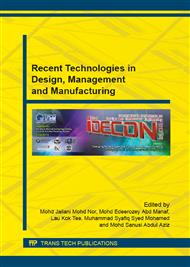p.659
p.664
p.668
p.673
p.678
p.683
p.688
p.693
p.698
Fatigue on Upper Quadrant Human Body: The Psychophysical Experience among Drivers
Abstract:
Upper body discomfort has become one of the issues to drivers nowadays. In this modern era, majority of Malaysian workers drive to work daily. This paper aims to find the most uncomfortable upper body part, as well as the effect of time, body mass index (BMI) and length of arm towards upper body discomfort for drivers. Sixteen volunteers were requested to complete the questionnaire soon after they completed driving the car simulator for three duration of times (30 minutes, 60 minutes and 90 minutes). Time is proven to be the main factor affecting the upper body comfort level, with the upper arm and lower arm being the most affected part during driving, [F(2,237) =14.37, p<0.01] compared to BMI and length of arm. It can be concluded that the upper body discomfort can be caused by driving for a long time. Nevertheless, the BMI and length of arm is not the issue for upper body discomfort.
Info:
Periodical:
Pages:
678-682
Citation:
Online since:
May 2015
Keywords:
Price:
Сopyright:
© 2015 Trans Tech Publications Ltd. All Rights Reserved
Share:
Citation:


